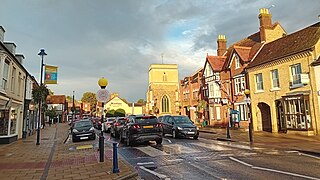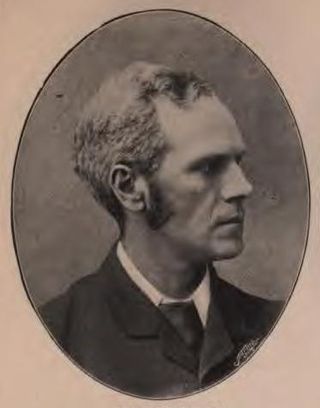
Francis Asbury was a British-American Methodist minister who became one of the first two bishops of the Methodist Episcopal Church in the United States. During his 45 years in the colonies and the newly independent United States, he devoted his life to ministry, traveling on horseback and by carriage thousands of miles to those living on the frontier.
The Methodist Episcopal Church, South was the American Methodist denomination resulting from the 19th-century split over the issue of slavery in the Methodist Episcopal Church (MEC). Disagreement on this issue had been increasing in strength for decades between churches of the Northern and Southern United States; in 1845 it resulted in a schism at the General Conference of the MEC held in Louisville, Kentucky.

Kempston is a town and civil parish in the Borough of Bedford, Bedfordshire, England, situated around 2 miles (3.2 km) south-west of Bedford town centre. It had a population of 19,330 in the 2011 census, and forms part of the wider Bedford built-up area. The River Great Ouse separates it from the Queen's Park area of Bedford.

Braunton is a large village, civil parish, ecclesiastical parish and former manor in Devon. The village is situated 5 miles (8 km) west of Barnstaple. It is one of the largest villages in Devon with a population at the 2021 census of 10,217 people. There are two electoral wards. Their joint population at the above census was 8,218. Within the parish is the fertile, low-lying Braunton Great Field, which adjoins the undulating Braunton Burrows, the Core Area in North Devon Biosphere Reserve, the largest psammosere in England. It confronts the Atlantic Ocean at the west of the parish at the large beach of Saunton Sands, one of the South West's international-standard surfing beaches.

Richard Whatcoat was the third bishop of the American Methodist Episcopal Church.

Harlington is a village and civil parish located in Bedfordshire, England, near the M1 motorway. The nearest town is Flitwick about 3 miles (4.8 km) to the north.

Shefford is a town and civil parish in the Central Bedfordshire district of Bedfordshire, England. At the 2021 census it had a population of 7,311. It lies 10 miles (16 km) south-east of Bedford.

Jabez Bunting was an English Wesleyan Methodist leader and the most prominent Methodist after John Wesley's death in 1791.
Oakley is a village and civil parish located in the Borough of Bedford in Bedfordshire, England, about four miles northwest of Bedford along the River Great Ouse. It has a population of 2,493 and is near the villages of Bromham, Milton Ernest, Clapham, Radwell and Felmersham.
This is a list of high sheriffs of Bedfordshire.

Fashionable novels, also called silver-fork novels, were a 19th-century genre of English literature that depicted the lives of the upper class and the aristocracy.

William Robert Bousfield was a British lawyer, Conservative politician and scientist.

Edward Thompson Taylor was an American Methodist minister. He joined the New England Annual Conference of the Methodist Episcopal Church in 1819 and was an itinerant preacher in southeastern New England for 10 years. In 1829, the Port Society of Boston hired Taylor to be the chaplain of the Seamen’s Bethel, a mission to sailors. In Boston, “Father Taylor” became famous as an eloquent and colorful preacher, a sailors’ advocate, and a temperance activist.

Annie Jane Schnackenberg was a New Zealand Wesleyan missionary, temperance and welfare worker, and suffragist. She served as president of the Auckland branch of the Women's Christian Temperance Union New Zealand 1887 to 1897, and national president for WCTU NZ from 1892 to 1901 – overseeing the final push for petitioning the government to grant women the right to vote in national elections. She also was a charter member of the National Council of Women of New Zealand.

The history of Methodism in the United States dates back to the mid-18th century with the ministries of early Methodist preachers such as Laurence Coughlan and Robert Strawbridge. Following the American Revolution most of the Anglican clergy who had been in America came back to England. John Wesley, the founder of Methodism, sent Thomas Coke to America where he and Francis Asbury founded the Methodist Episcopal Church, which was to later establish itself as the largest denomination in America during the 19th century.

St Michael's Church at Chenies, Buckinghamshire, is a Grade I listed Anglican parish church in the Diocese of Oxford in England. It is not of great architectural interest but stands in an attractive position in the Chess Valley near the Chenies Manor House. The church is famous for its Bedford Chapel, the mausoleum of the Russell family which is private and not open to the public.
Sarah Herbert (1824–1846), was an Irish-Nova Scotian author, publisher and educator.

Elizabeth Brentnall was an Australian suffragist, temperance activist and philanthropist. She was the first state president (1885–99) then honorary president of the Woman's Christian Temperance Union (WCTU) in Queensland.
Frank Erni Dawkins was an English political activist known for advocating wealth redistribution, strong public programmes, and policies supporting the nationalisation of key industries. His political career included a 1909 assault in Ilford, highlighting the tensions between socialism and religious views. Dawkins' advocacy for socialism spanned from economics to community engagement. He represented the Labour Party in Hampstead in the 1929 general election. Dawkins's Methodist background and political career is a classic example of the early 20th century transition from methodism to socialism in the context of the view taken by some observers that 'socialism owes more to Methodism than Marxism'.












